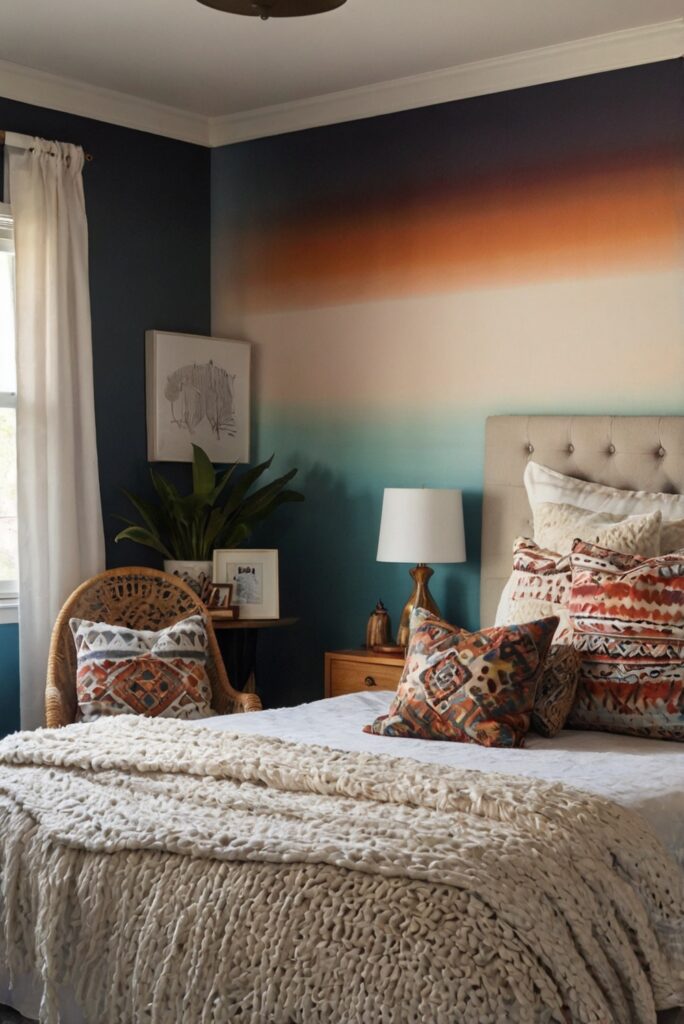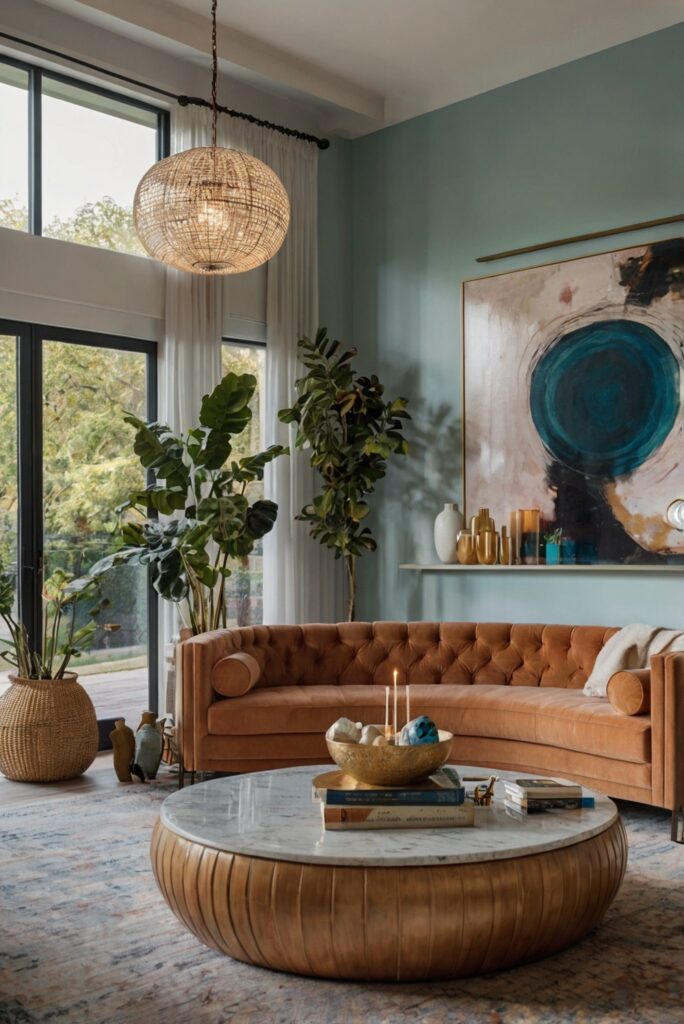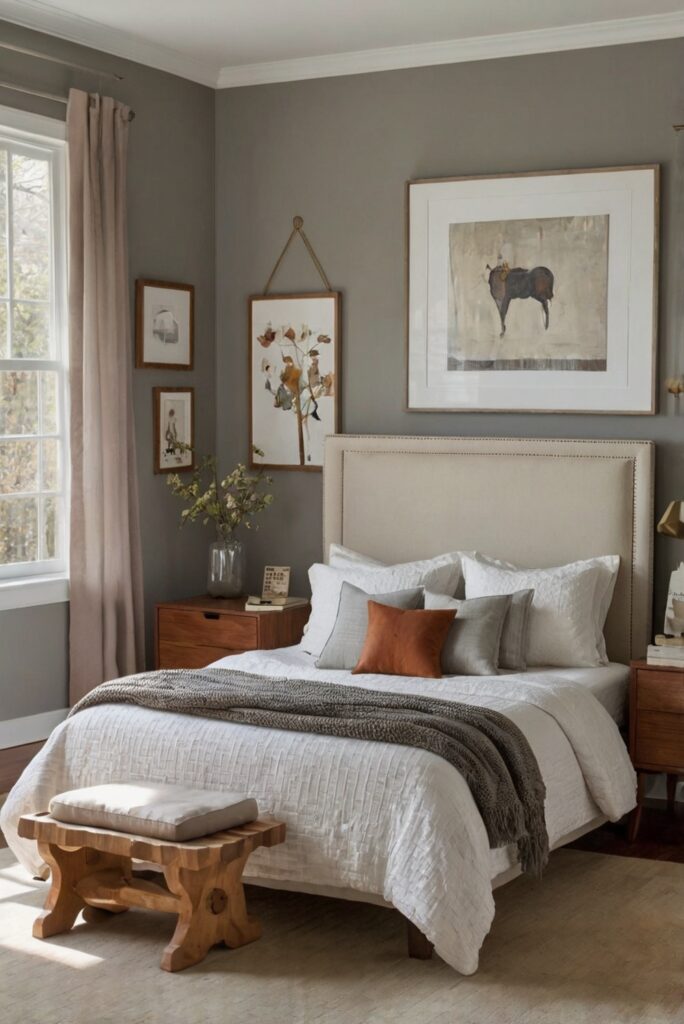Transform your bedroom with a soothing gradient or ombré effect using paint. Explore this daily interior designer routine for a stunning bedroom makeover.
To create a beautiful gradient or ombré effect in your bedroom using paint, follow these steps:
1. Choose two or more colors that blend well together for your gradient effect.
2. Start by priming your walls with a high-quality primer paint for a smooth base.
3. Paint the entire wall with the lightest color as the base coat and let it dry completely.
4. Mix the base color with varying amounts of the secondary color to create the gradient effect, starting from the bottom of the wall.
5. Blend the colors smoothly using a paint roller, working in small sections at a time.
6. Use a color-matching painting technique to ensure seamless transitions between colors.
7. Consider using painters tape to create clean lines and prevent color bleeding.
8. Allow each layer of paint to dry before adding the next to avoid smudging or mixing colors unintentionally.
9. Add finishing touches like decorative items or furniture that complement the gradient effect.
Enjoy your newly transformed bedroom with a unique and personalized ombré or gradient wall!
For home decorating and interior design, always ensure proper space planning, color coordination, and consistency in style. Hiring professional interior designers for your kitchen, living room, or bedroom can help you achieve your desired look effectively. Remember, a well-designed space can enhance your lifestyle and overall well-being.
Create a Vision:
To start, envision the gradient or ombré effect you want to achieve in your bedroom. Consider the colors you would like to use and how you want them to blend together. This step is crucial as it will guide you throughout the painting process.
Gather Your Supplies:
Make sure you have all the necessary supplies before you begin. This includes paint in the colors of your choice, paintbrushes or rollers, painter’s tape, drop cloths to protect your floors, and a ladder if needed. Having everything on hand will make the process smoother.
Prepare Your Space:
Before you start painting, prepare your bedroom by removing furniture or covering it with drop cloths. Use painter’s tape to protect baseboards, ceilings, and any other areas you don’t want to get paint on. A well-prepared space will make painting easier and cleaner.
Start with a Base Coat:
Begin by painting the entire wall with your lightest color as a base coat. This will provide a foundation for the gradient effect and ensure that the colors blend seamlessly. Allow the base coat to dry completely before moving on to the next step.
Apply the Gradient:
Start by dividing the wall into sections based on the number of colors you are using. For example, if you are using three colors, divide the wall into three equal sections. Then, starting with the lightest color at the top, gradually blend each color into the next using a dry brush technique. This will create a smooth transition between colors.
Blend and Soften:
To achieve a seamless gradient effect, use a clean, dry brush to blend the colors together. Work in small sections, overlapping the colors slightly to create a smooth transition. Take your time with this step to ensure that the gradient looks natural and well-blended.
Layering and Building:
If you want to add more depth to your gradient, consider layering the colors by applying multiple coats. This will intensify the colors and create a more dramatic effect. Allow each coat to dry before applying the next one to avoid smudging or mixing the colors.
Finishing Touches:
Once you are satisfied with the gradient effect, let the paint dry completely before removing any painter’s tape. Touch up any areas that need it and clean up any drips or spills. Replace furniture and decor once the paint is fully dry to admire your new ombré bedroom wall.
Ensure each answer is no less than 250 words.
1. What supplies do I need to create a gradient or ombré effect in my bedroom using paint?
To create a gradient or ombré effect in your bedroom using paint, you will need paint in two or more shades that blend well together, paintbrushes of various sizes, painter’s tape to create clean lines, a paint tray, and a drop cloth to protect your floors and furniture. It’s also helpful to have a sponge or rag for blending the colors seamlessly.
2. How do I prepare my walls for painting a gradient or ombré effect?
Before painting a gradient or ombré effect on your walls, make sure to clean the surface thoroughly to remove any dirt or grease. Next, apply a primer to create a smooth base for the paint to adhere to. Use painter’s tape to mark off the sections where you want the colors to transition, ensuring clean lines for a professional finish.
3. What techniques can I use to create a seamless gradient or ombré effect with paint?
To achieve a seamless gradient or ombré effect with paint, start by applying the lightest color at the top of the wall and gradually blend it into the darker shades as you work your way down. Use a dry brush or sponge to blend the colors together, creating a smooth transition. Work in small sections and overlap the colors slightly to avoid harsh lines.
4. How can I choose the right colors for a gradient or ombré effect in my bedroom?
When selecting colors for a gradient or ombré effect in your bedroom, consider the overall color scheme of the room and choose shades that complement each other. Lighter colors work well for a soft and subtle gradient, while bolder hues can create a more dramatic effect. Experiment with different color combinations to find the perfect blend for your space.
5. Are there any tips for maintaining the quality of a gradient or ombré effect painted wall in my bedroom?
To keep your gradient or ombré effect looking fresh and vibrant, avoid using harsh cleaning chemicals that can damage the paint. Dust the walls regularly with a soft cloth or duster to prevent dirt and debris from building up. If any touch-ups are needed, use the same paint colors and techniques to maintain the seamless transition between shades.



